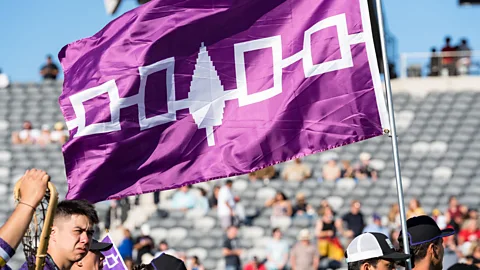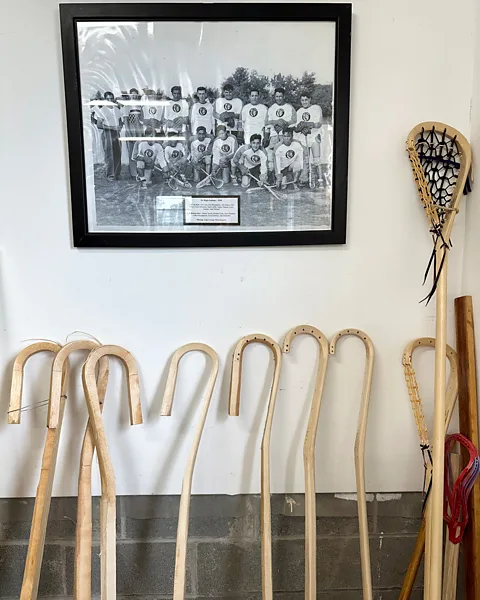The Indigenous roots of a revived Olympic sport
 Alamy
AlamyOne of the fastest growing sports in North America, lacrosse is headed back to the Olympics. But the game's creators may not be invited.
When First Nations Haudenosaunee people say that someone was born with a lacrosse stick in their hand, it's not far from the truth. "We have these little cradle sticks," says Lewis Mitchell, a lacrosse stick-maker and lifelong player. "Parents who want their children to play lacrosse, they take that stick and they put it into the cradle with the baby."
Mitchell's workshop is in Snye, Quebec, a pene-exclave of Canada south of the St Lawrence River. Snye, or Tsi Snaihne in Kanienʼkéha, the Mohawk language, is part of the Mohawk territory of Akwesasne, which straddles the US-Canada border and has portions in New York, Ontario and Québec. Lacrosse has deep roots here. The game is said to have been invented around 1,000 years ago by the Haudenosaunee – the confederacy made up of the Mohawk, Onondaga, Oneida, Cayuga, Seneca and Tuscarora nations of north-eastern North America – and Akwesasne once produced most of the world's wooden lacrosse sticks.
Since the advent of plastic sticks in the 1970s, wooden sticks are today largely made for nostalgic, decorative or ceremonial purposes, but Mitchell and his fellow lacrosse stick-maker Evan Cree help ensure that the craft is not lost. Workshop visits with both men are part of Akwesasne's emerging tourism industry, which weaves lacrosse into its tours as a lens into its culture, history and artistry. Whether viewing exhibits on the evolution of lacrosse at the Akwesane Cultural Center or learning about log pounding while watching basket maker Carrie Hill at work, the topic of lacrosse is a frequent one in Akwesasne.
And this combination of cultural tourism and sport hits a sweet spot: not only is Indigenous tourism rapidly growing, so too is lacrosse. It's one of the fastest growing sports in North America and recently received another boost: in 2028 lacrosse will be competed at the Olympic Games in Los Angeles for the first time in more than a century – in the compact sixes format.
 Karen Gardiner
Karen GardinerAs Mitchell leads me through the steps of turning a hickory to a lacrosse stick – bending the top of the stick around a jig to form the head, then carving it with a drawknife on a shaving horse (a combined vice and workbench) – he fills me in on his years of playing lacrosse with Akwesasne teams and competing internationally as a member of the Iroquois (now Haudenosaunee) Nationals. Mitchell was inducted into the Akwesasne Hall of Fame in 2015 and the Ontario Lacrosse Hall of Fame in 2019 but he's humble about his own achievements. It's when he starts talking about the lacrosse "legends" he played against during his heyday that I sense he could keep talking all day. He reminisces about the "great rivalries" with other Mohawk communities such as Kahnawáke, near Montreal, and re the "honour" of playing against Sid Hill, now Tadodaho, or traditional leader, of the Onondaga Nation.
The ion with which Mitchell speaks about lacrosse is typical of many Haudenosaunee, to whom it's more than just a game. Many believe that lacrosse was a gift from the Creator for enjoyment and healing, and it appears in Haudenosaunee creation stories. The wooden stick, traditionally made from natural materials (wood and sinew) has its own spiritual significance. To this day lacrosse is played as both competition and ceremony – during times of difficulty, "medicine games" are called to lift the spirits of communities in need, Mitchell explains.
Medal Moments
Want to read more about the Olympics? Sign up for window._taboola = window._taboola || []; _taboola.push({ mode: 'alternating-thumbnails-a', container: 'taboola-below-article', placement: 'Below Article', target_type: 'mix' });
